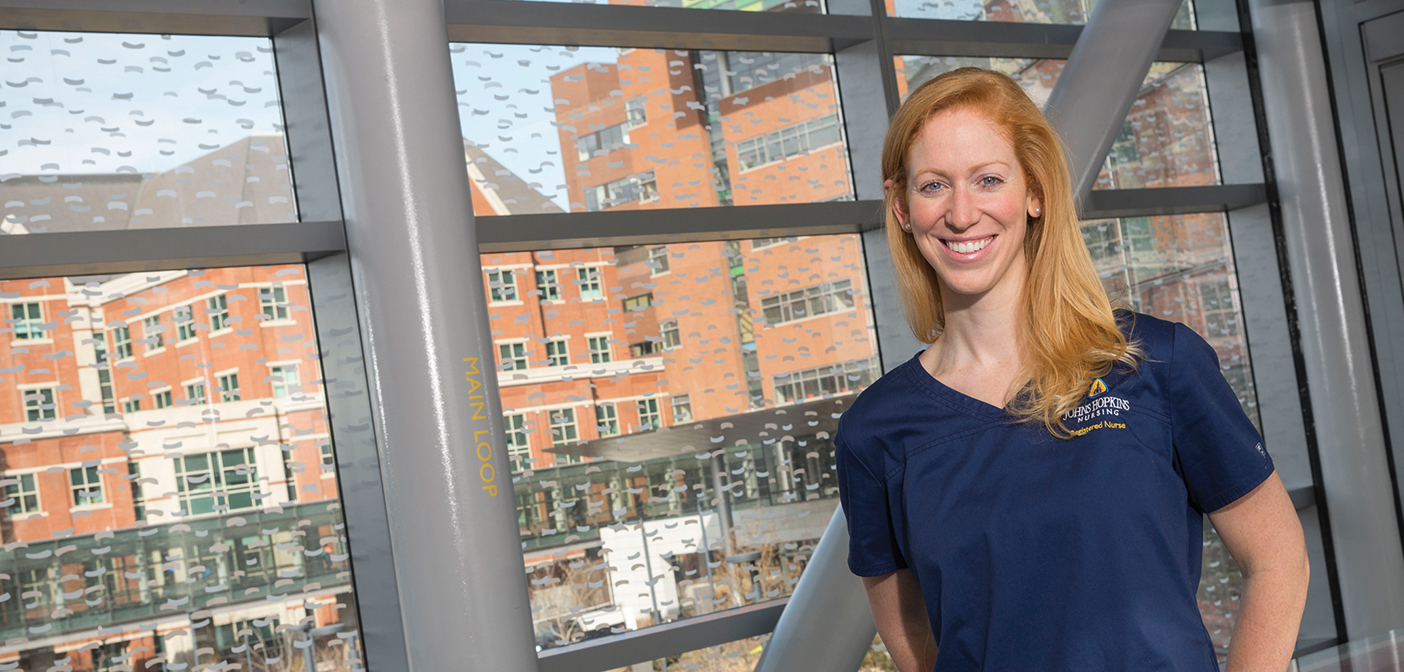Pilot clinical program helps students put one foot, then all of themselves, into an ICU
New nurses generally don’t walk out of the NCLEX testing site and into a job at an intensive care unit at The Johns Hopkins Hospital. So when Ann Marie Albright learned about a pilot program that would allow select students from the Hopkins School of Nursing to gain priceless experience in an ICU across the street and even get a job at graduation, she jumped. “It was tailor-made,” she says.
Albright was one of six in the Student Transitions Pilot: a Johns Hopkins Hospital and School of Nursing partnership developed to help end nurse shortages in surgical critical care and post-anesthesia units at the hospital. It does so, in large part, by addressing a Catch-22 situation.
“The seed of the problem is new graduate nurses can’t get jobs in ICUs because ICUs require a practicum,” explains Deb Baker, DNP, ACNP, director of Nursing for Surgery, Ophthalmology and Rehabilitation at Hopkins Hospital. “And they can’t get a practicum because when it comes to going to ICUs for [a traditional] Transitions class, ICUs don’t have enough preceptors for them.”
“The seed of the problem is new graduate nurses can’t get jobs in ICUs because ICUs require a practicum. And they can’t get a practicum because when it comes to going to ICUs for [a traditional]
Transitions class, ICUs don’t have enough preceptors for them.”
— Deb Baker, DNP, RN, ACNP
In this case, instead of students being matched one-to-one with a preceptor, they would be immersed in the cardiovascular surgical intensive care unit (CVSICU), cardiovascular progressive care unit (a step-down unit called the CVPCU), or post-anesthesia care unit (PACU). Students would also spend clinical time in a simulations lab, at a seminar course, and in conferencing for a total of 168 hours from October to December. Successful participants would later be offered jobs in the area of their focus (CVSICU, CVPCU, or PACU) or elsewhere in the hospital.“I really thought that this was a win-win situation, where students would be excited about the opportunity both to have a job at the hospital and a Transitions placement at the hospital, and it would work really well for the hospital to get some really qualified nurses,” says Hayley D. Mark, PhD, MPH, RN, director of the baccalaureate program at the School of Nursing.
During the pilot, students moved between units to gain perspective on the entire process of care. For instance, Albright followed a cardiac patient as he transitioned to other units. “It made me see the entire flow of things, the big picture of patient care at Hopkins,” she says.
As students rotated spots, JHH nurse faculty remained with them. “Each one of these students is assigned to a nurse on the unit, but we had extra faculty who helped do that critical thinking with them,” Baker says.
Based on evaluations, all six students considered the pilot a success for them personally. And why not? “In the process of doing this, we were saying, ‘We’re going to hire you in these areas, or we’re going to find you a spot somewhere that is right for you,’ ” says Martha Kennedy, PhD, RN, CRNP-AC, nurse practitioner, Weinberg Intensive Care Unit and education lead, department of Surgery at Hopkins Hospital.
Hired students are asked to make a three-year commitment to the hospital so that all benefit from the investment. Plans and logistics for next phases of the program are being ironed out.
Albright, now a registered nurse, recently started her job in the CVSICU. “I’m over the moon, because my career goals and aspirations were to: one, get a job at Hopkins Hospital; two, do it in cardiology; three, do it in critical care,” she says.
Photo by Jon Christofersen

